Acoustic Instrument
Primers
What Kind of Guitar
Should I Start On?
What Kind of Banjo
Do I Want?
Evaluating and
Buying Used
Guitars
Setting Up
Fretted Instruments Whatever Happened
to the Banjo?
Beginning Five-
String Banjo
6-String Banjos
Banjo Pickups
Axes in my Life
What is a
Bluegrass Banjo?
Dean "Backwoods
Six" Shootout
Music Theory
Primers
Introduction
to Scales
Introduction
to Chords
Circle of Fifths
Other Articles
About Music
How to Give
Guitar Lessons
Musician or
Wannabe? Did God Really
Give Rock &
Roll to You?
Are You a
"Brand Bigot"?
Who Owns Folk Songs?
Historical Links
About the
National Road
The Story Behind
the Story - Real
People, Places,
and Events
About the Play
Play Home
What's New
Overview
About the
Music
About the
History
About the
Logistics
About the
Cast
Synopsis
About the
Set
About the
Author
Contact Us
Home

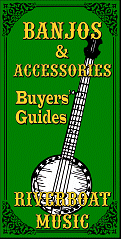

|

|
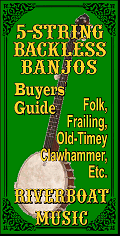
Beginning Five-String Folk Banjo - Part Nine: Standard (C) Tuning (DBGCg)
| Written by Paul Race for Creek Don't RiseTM and School Of The RockTM |
This is a follow-up to Lesson 8 More 3/4 and More Chord Stuff, which was intended to help you get out of the "three-chord" rut. By all rights, this lesson should probably just introduce a few more chords. Instead we're going to introduce Standard banjo tuning, something I think every banjo player should know or at least know about.
We haven't exactly exhausted all the things you can do in the key of G, but you can do a lot of them in other keys. And learning other keys will allow you to jam with people who play guitar and other instruments without insisting that they play every song in your favorite key. (We'll touch on playing in D and A in a future lesson.)
Standard Banjo Tuning - Between 1850 and 1967, most five string banjos were tuned most of the time to what we now call "C tuning." (In fact, the earliest four-string "plectrum" banjos and guitars - used in early Jazz - used the same tuning as well, minus the high G note.)
C tuning (DBGCg) is just the same as the "G tuning" we've been using so far (DBGDg), except that the fourth string is a step lower. That makes the lowest note you can play on your 5-string a C instead of a D. This is also called DBGCg tuning, counting from the string furthest from your chin upward.
As late as 1967, if you heard a banjo on mainstream radio, it was nearly always in C tuning - even if the song was in the key of G!
For one thing, if your banjo's in C tuning, it's still very easy to play a song in the key of G. But if your banjo's in G tuning, it's a little more difficult to credibly play songs in the key of C.
So C was the more useful tuning for 5-string banjo players who were part of ensemble that featured but didn't revolve around banjo, including the Weavers, the Limeliters, and the Kingston Trio, to name a few. (The banjo players in all three groups also used a specially modified "long-neck" banjo that we hope to discuss in a future lesson, but they used C tuning most of the time.)
The Great Banjo Tuning Shift - What changed? Starting about 1945, Earl Scruggs and a few other performers began impressing Grand Ol' Opry fans with a kind of rapid-fire solo picking that is easier to play in G tuning. But it wasn't until the Bonnie and Clyde soundtrack (1967) put "Scruggs Picking" on the mainstream radio that the "great tuning shift" from C to G gained momentum outside of "Op'y" fans.
Nowadays, several of my favorite banjo books from the 1960s get one-star reviews on Amazon because they include songs in C tuning. "I thought this was supposed to be a banjo book!" is a common complaint. In an era when many folk, rock, alternative, and pop guitar players experiment with alternate tunings constantly, it is a little demoralizing to realize how many pickers think that dropping that fourth string one note to play classic banjo tunes is too much to ask.
Accompaniment in the key of C - For modern 5-string pickers acclimated to G tuning, one major benefit of being able to play in C is to accompany singers (including yourself) who find that their favorite songs are out of their vocal range if they stay in G. C as a "Stepping Stone" for Other Keys - In addition to letting you play more credibly in the key of C, learning C tuning helps you play in weird keys like Eb (using a capo, which we'll discuss in a later lesson). True, the majority of five-string players today avoid any venue or musical style that would force them to play in such keys, but that's not because the banjo lacks imagination or confidence.
The other chords are similar to chords you already know - the only difference is what happens on the fourth string.
Just as G has three chords you're likely to use in every song, here are the three chords you're most likely to use when playing in the key of C, plus the Dominant Seventh chord (G7, a version of which you already know)
Chords in C Tuning
Because C tuning is so close to G tuning, there's really only one new chord to learn: F. If you remember from your Circle of Fifths, F is to C as C is to G. It's the Fourth, the Subdominant, or the IV chord in the key of C.
1, or I |
4, or IV |
5, or V |
5 Seventh, or V7 |
 |
 |
 |
 |
Example: "Go Tell Aunt Rhody"
We'll start with an old Southern African-American song that started appearing in children's songbooks back in the day when publishers were afraid that telling its origin would keep their books from being sold in the South.
You can accompany it on just two chords, C and G. Click this icon to hear our first, simple accompaniment played with the melody. 
Click the little icon to the right to hear this accompaniment played without the melody. 
In both cases, do you hear the "gutsy" kick of that low C, something you never hear in G tuning? Irish Tenor (EADG) banjos go lower than that, and Six-String banjos (EBGDAE) go lower than that, but to me even this sonority adds a pioneer or "Western" roots feel that is largely lacking from banjo music today.
To see printable sheet music, click on the staff below.
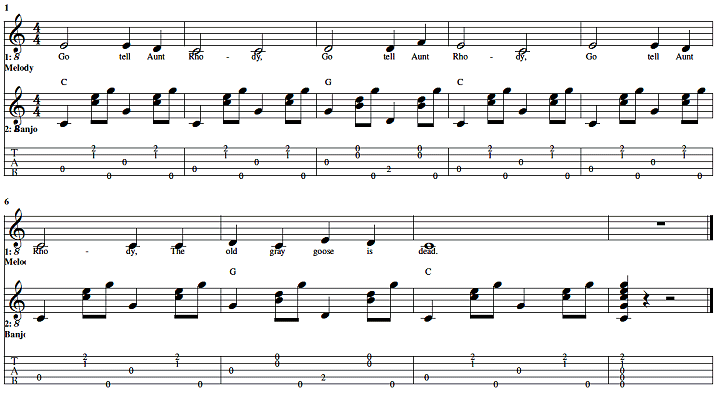
Adding a Hammer - Hammering on and pulling off work in the key of C just fine. In a moment, we'll show you a lick that Pete Seeger was doing  thirty years before Bluegrass banjo was invented. You'll hear it in a lot of old Weavers recordings as well as a lot of his solo work, and the work of his disciples in the Folk Revival.
thirty years before Bluegrass banjo was invented. You'll hear it in a lot of old Weavers recordings as well as a lot of his solo work, and the work of his disciples in the Folk Revival.
Here's the lick: while you're in the C chord, you hit the low C on beat 1, but when you come to beat three, instead of just playing G, you hit the G then hammer up two frets to an A. Technically, that turns the C chord into a C6 chord, but nobody ever really notices that. It just adds a little fill. Click this icon to hear this pattern played: 
We've also added a "hammer" to the G chord, and we've changed it to a G7, as shown in the little chord chart table above.
 Finally, we've dropped the C to its relative minor - A minor - in measure 6. This doesn't actually sound all that impressive in this tuning, but it's a very common practice in folk songs with this sort of melodic structure, and you might as well get used to listening for it, at least.
Finally, we've dropped the C to its relative minor - A minor - in measure 6. This doesn't actually sound all that impressive in this tuning, but it's a very common practice in folk songs with this sort of melodic structure, and you might as well get used to listening for it, at least.
A minor seventh (Am7) in C tuning is shown to the right. Because we're ignoring the fourth string for now, it looks just like the Am7 we've been using in G tuning.
Click this icon to hear this version of the accompaniment played with the melody. 
Click the little icon to the right to hear this accompaniment played without the melody. 
To see printable sheet music, click on the staff below.

Playing Solo - Keeping in mind that C tuning is used mostly for accompaniment and not for solos, quite a few folk song melodies can be played in C. The version below is based on the way my friend Bernie Stolls played this song all the way back in the 1960s. (That's why we credit him in the sheet music version.")
Click this icon to hear it played. 
To see printable sheet music, click on the staff below.
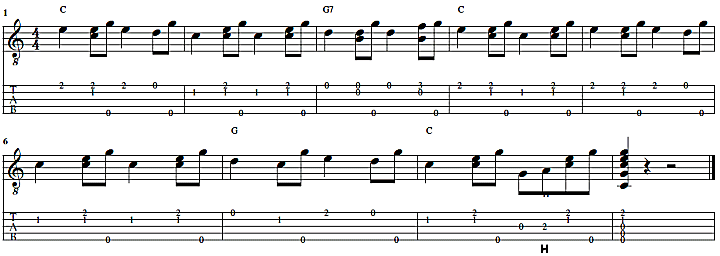
 Alternate C Chord - For some 5-string banjo solos in C, we take advantage of an alternate version of the C chord that is show at the right. It's played in part by laying your ring finger over strings 1-3 in a partial "barre," and fretting the fourth string on the fourth fret.
Alternate C Chord - For some 5-string banjo solos in C, we take advantage of an alternate version of the C chord that is show at the right. It's played in part by laying your ring finger over strings 1-3 in a partial "barre," and fretting the fourth string on the fourth fret.
We don't usually use the whole chord, but sometimes we use part of it to play the low E without obliterating the rest of the roll. In some cases, this allows us to move the melody onto the lower notes.
 In the following arrangement, we use a partial version of this chord only on the measures that require the low E. If you have trouble playing the full version above, you'll be relieved to know that you only need to "barre" the first two strings, which is much easier. Technically, this isn't a C chord, since there isn't a C in it anywhere, but it "holds down the fort" in this song until we get back to a classic C chord.
In the following arrangement, we use a partial version of this chord only on the measures that require the low E. If you have trouble playing the full version above, you'll be relieved to know that you only need to "barre" the first two strings, which is much easier. Technically, this isn't a C chord, since there isn't a C in it anywhere, but it "holds down the fort" in this song until we get back to a classic C chord.
Click this icon to hear this arrangment played. 
To see printable sheet music, click on the staff below.

Example: "Oh, Susannah"
This is one of Stephen Foster's most popular songs, originally written for a blackface minstrel show, but now usually published with all of the obviously racist and offensive lines left out. In the 1960s, the New Christy Minstrels' producer Randy Sparks wrote a version that is funny and not racist, though still potentially offensive, called "Oh Susianna." Lines include:
We was comin' out of Denver, the weather being fine,
Goin' to Kansas City on that Rock Island line.
Ninety miles of grade ahead, and we heard the brakes give out.
Some of the boys began to pray, but I began to shout:
Oh, Susianna, don't mean to cause you pain.
You know I love you, honey, but your face would stop a train.
Click this icon to hear our first, simple accompaniment played with the melody. 
Click the little icon to the right to hear this accompaniment played without the melody. 
To see printable sheet music, click on the staff below.

Playing Solo - There are probably as many ways to play this solo as there are banjo players. Here's one way that builds on the principles shown above and in earlier lessons. The third note (E) can be picked or can be slid up to, depending on your preference. If you're going to slide, you first pick the fourth string unfretted, then hammer viciously on the second fret and slide the same finger up to the fourth fret, trying to keep the string ringing. If this doesn't work for you, and you have the right-hand dexterity to pick the E on the fourth fret of the fourth string, you may certainly do that instead.
When the song goes to F, we chose a simple part you can do just by fretting the third string right next to where you've been fretting the fourth string. Some pickers play up there all the time, but I don't, so I get you back down to root position on the next measure.
Note: If you don't "get" this solo, or never "nail it," that doesn't mean you should hang your head in shame. Soloing in C takes a tad more practice than a lot of solos in G - that's why you don't hear it as often. The main thing is to try and figure out the basic principles of the thing. If nothing else, you should never have to "drop out" entirely when someone in a band or jam session proposes playing a song in the key of C again.
Click this icon to hear it played. 
To see printable sheet music, click on the staff below.
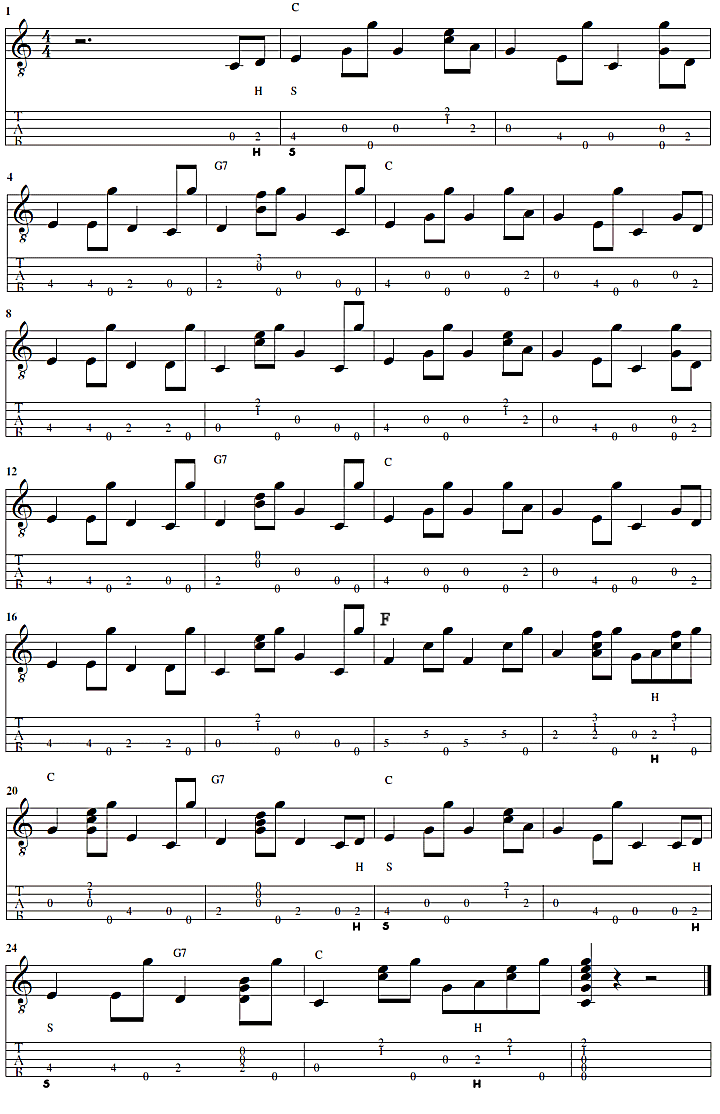
For More Practice
Remember our old friend "Buffalo Gals"? Turns out that when you play the whole song (including a chorus almost nobody ever sings), the song is a lot easier to sing in C than G. So we've added banjo arrangements for the song in both G and C, including accompaniments and solo tabs. Do yourself a favor and work on the C versions at least as hard as you work on the G versions - you'll separate yourself from a lot of wanabees if you can accompany songs in C, and from even more if you can solo in that key. And if you are ever asked to lead a group of people in singing this song, you'll find that they're a lot more likely to sing along in the key of C.Click here to jump to the article featuring multiple arrangements of this tune in the keys of C and G.
More Chords
The following chord chart shows the most likely chords to be used in C tuning. Since most banjo players prior to 1967 also used this tuning to play songs in G, we have noted tonic, dominant, and subdominant chords for the keys of both C and G.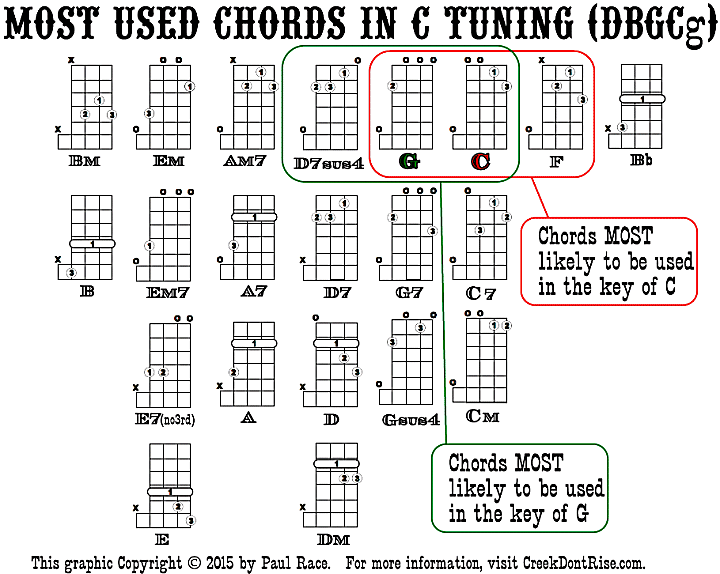
In addition, here are a number of songs whose melodies are either usually sung in C or structured in such a way that they are relatively easy to pick in C. If there's interest, and we have time, we'll revisit them and add a tabulature at some point in the future.
- Sweet Betsy from Pike
- Scarborough Fair
- Wayfaring Stranger
- All My Trials
- The Bear Went Over the Mountain
- Casey Jones
- Momma Don't 'Low
- Roll in my Sweet Baby's Arms
- When the Saints Go Marching In
- John Brown's Body
- One More River
- This Old Man
- Wearin' of the Green
Conclusion
Even if you never get good at playing solos in C tuning, being able to accompany people in C means that you can play along on more songs and broaden your musical horizons. If you are a fan of any 1950s or 1960s Folk group that used a 5-string banjo, you'll find learning their songs much easier.In our next lesson we will cover an alternate tuning that makes it easy to play in D and A. Later, we'll discuss ways professional banjo players play in all sorts of other keys.
And contact us if you're hitting any brick walls. :-)
Best of luck, all, enjoy your music, and support the arts.
Paul Race

All material, illustrations, and content of this web site is copyrighted © 2001, 2002, 2003, 2004, 2005, 2006,
2007, 2008, 2009, 2010, 2011, 2012, 2013, 2014, 2015 by Paul D. Race. All rights reserved.
Creek Dont' Rise(tm) is a participant in the Amazon Services LLC Associates Program, an affiliate advertising
program designed to provide a means for sites to earn advertising fees by advertising and linking to Amazon.com.
For questions, comments, suggestions, trouble reports, etc. about this play or about this web page, please contact us.
| Visit related pages and affiliated sites: | ||||||
| - Music - | ||||||

|
 |
 |

|

|

|
|

|

|

|

|

|

|
|
| - Trains and Hobbies - | ||||||
 |

|

|  |
 |

|
|
| - Christmas Memories and Collectibles - | ||||||
 |

|
 |

|
 |

|
|
| - Family Activities and Crafts - | ||||||
 |

|

|

|

|

|
|
